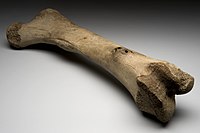
Photo from wikipedia
Abstract Context Morinda officinalis F.C. How. (MO) (Rubiaceae) can strengthen bone function. Objective To examine the functional mechanism and effect of MO polysaccharides (MOPs) in rats with glucocorticoid-induced osteoporosis (GIOP).… Click to show full abstract
Abstract Context Morinda officinalis F.C. How. (MO) (Rubiaceae) can strengthen bone function. Objective To examine the functional mechanism and effect of MO polysaccharides (MOPs) in rats with glucocorticoid-induced osteoporosis (GIOP). Materials and methods Rats with GIOP were treated with 5, 15 or 45 mL/kg of MOP [n = 15 for each dose, intraperitoneal (i.p.) injection every other day for 8 weeks]. The body weight of rats and histomorphology of bone tissues were examined. Bone marrow mesenchymal stem cells (BMSCs)-derived exosomes (Exo) were collected and identified. Bone marrow-derived macrophages (BMMs) were induced to differentiate into osteoclasts and treated with BMSC-Exo for in vitro studies. Results MOP reduced the body weight (5, 15, or 45 mg/kg MOP vs. phosphate-buffered saline: 8%, 15% and 25%, p < 0.01), elevated the bone volume to tissue volume (BV/TV), mean trabecular thickness (Tb.Th), mean trabecular number (Tb.N) and mean connectivity density (Conn.D) (40–86%, p < 0.01), decreased the mean trabecular separation/spacing (Tb.Sp) (22–37%, p < 0.01), increased the cortical bone continuity (35–90%, p < 0.01) and elevated RUNX family transcription factor 2 and RANK levels (5–12%, p < 0.01), but suppressed matrix metallopeptidase 9 and cathepsin K levels (9–20%, p < 0.01) in femur tissues. BMSC-Exo from MOP-treated rats (MOP-Exo) suppressed osteoclastic differentiation and proliferation of BMMs. The downregulation of microRNA-101-3p (miR-101-3p) or the upregulation of prostaglandin-endoperoxide synthase 2 (PTGS2) blocked the functions of MOP-Exo. Discussion and conclusions MOP inhibits osteoclastic differentiation and could potentially be used for osteoporosis management. This suppression may be enhanced by the upregulation of miR-101-3p or the inhibition of PTGS2.
Journal Title: Pharmaceutical Biology
Year Published: 2022
Link to full text (if available)
Share on Social Media: Sign Up to like & get
recommendations!